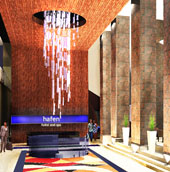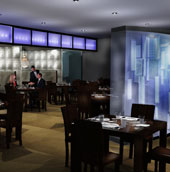AMES, Iowa -- Designs by three Iowa State University senior interior design students triumphed in the fifth annual Hospitality Design Awards competition sponsored by Hospitality Design magazine. The competition recognizes outstanding design projects in 13 categories related to the hospitality industry.
Michael Goodsmith, Cedar Rapids, won first place in the student category with his conceptual designs for a sustainable nightclub. A concept for an upscale hotel and spa by Anna Anderson, Waukee, and Jennifer Irey, Davenport, was a finalist.
Winners and finalists will be honored at an awards presentation and reception on June 4 in New York City. Projects will be published in the May/June issue of Hospitality Design.
The Iowa State students developed their projects this semester in the interior design senior studio taught by assistant professor Jihyun Song. Song offered the class three assignment options: design a grocery store, a hotel or a nightclub--and integrate sustainable principles into the project.
Sustainable nightclub
Goodsmith's project, Estrella Sustainable Nightclub, renovates an existing structure in New York City's West Village into an eco-conscious nightclub with an energy-generating dance floor and other green features. Estrella means "star" in Spanish.
Goodsmith searched real estate listings online for a site that met criteria he felt were critical to successful development, including a building with appropriate square footage and roof access for alternative energy sources, in a densely populated area with a mass transit system and established nightlife nearby.
"Anymore, all design needs to be sustainably driven," Goodsmith said. "My career interests lie in events, entertainment and hospitality design. It's a fun, creative challenge to incorporate sustainability into those markets, where it's not yet common. No one thinks a nightclub should be sustainable, but why not?"
Jana Schiowitz, project manager for the HD Awards, said the judges were very pleased with Goodsmith's entry "because sustainability is at the forefront of the design industry."
"Michael addressed green design throughout his concepts and materials and this was gratifying -- to see a student present something that addressed the key issue of sustainable design," Schiowitz said.
Innovative energy-saving features
For example, a nightclub consumes a large amount of energy for lighting and music, Goodsmith said. So he incorporated renewable energy from three wildlife-friendly wind turbines and a "piezoelectric" dance floor -- which converts dancers' motion into electricity -- to power lighting and sound equipment.
Energy-efficient LEDs and a water wall that cools the dance-floor area also help reduce energy use.
"The water wall acts both as a cooling system and as a projection screen where the club can project a meter that measures the level of electricity the dancers are producing. It's almost a motivator to dance harder. It could also be used for videos or light shows," Goodsmith said.
Additionally, the Estrella nightclub design incorporates a variety of sustainable materials such as polished concrete, recyclable carpet tiles and the brick walls of the existing structure. Other green amenities include high-quality furnishings that will hold up to heavy use and interior garden sculptures that improve indoor air quality.
Goodsmith also designed a tapas bar for the club to serve locally grown and organic products, some of which could be grown in a roof garden.
"This was a great project for my last semester of college," Goodsmith said. "I'm really grateful that [Professor Song] encouraged us to submit our work to the competition. It's a good learning experience to know what it takes, the pressures and issues you face when trying to get a project ready for competition."
Hotel concept
For their project--titled Hafen--Anderson and Irey designed a conceptual plan for a new hotel near Dubuque. They focused on public spaces rather than guest rooms and sought to create a unique regional destination that embraces the area's immigrant heritage as well as the importance of the Mississippi River to commerce and recreation.
"We began by researching the city's history, including its German heritage and its dependence on the river for economic prosperity," Irey said. "We also drew from local industries and culture, and pulled those aspects together to create a concept of European clarity and openness.
"'Hafen' (which means harbor, port or haven in German) seemed like a natural name for our hotel," she said.
The theme is carried through the facility with the Ice Harbor Bar and Restaurant, the Haven Spa and the Port Gift Shop, which would sell locally made health and spa products.
"We expanded our project to three levels and developed the spa/gift shop as the entire basement," Anderson said. "The second floor is a mezzanine so that natural light will fill the space."
Irey and Anderson's design also incorporates natural and sustainable materials, such as recycled glass and resin, reclaimed wood and local stone. Drawing on the Ice Harbor theme, they used glass and custom lighting to produce a cool, blue atmosphere.
A signature glass light fixture drops down from the mezzanine level to serve as a focal point in the lobby and guide patrons to the spiral stair leading to the spa. Tall ceilings, glass partition walls, reflective materials and dramatic lighting all are intended to produce a sense of openness.
Irey, who designed the lighting features and partition walls, intends to pursue a graduate degree in lighting design. Anderson, who planned the space, wants to work in the hospitality design profession.

